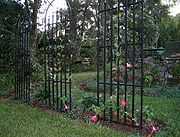Trellis (architecture)



A trellis (treillage) is an architectural structure, usually made from an open framework or lattice of interwoven or intersecting pieces of wood, bamboo or metal that is normally made to support and display climbing plants, especially shrubs.[1] There are many types of trellis for different places and for different plants, from agricultural types, especially in viticulture, which are covered at vine training systems, to garden uses for climbers such as grapevines, clematis, ivy, and climbing roses or other support based growing plants. The rose trellis is especially common in Europe and other rose-growing areas, and many climbing rose varieties require a trellis to reach their potential as garden plants. Some plants will climb and wrap themselves round a trellis without much artificial help being needed while others need training by passing the growing shoots through the trellis and/or tying them to the framework.
Trellis can also be referred to as panels, usually made from interwoven wood pieces, attached to fences or the roof or exterior walls of a building. A pergola usually refers to trellis-work that is laid horizontally above head height to provide a partial "roof" in a garden (pergolas are also used in agricultural settings).
While metal trellises are typically very ornate, they may not be the best choice for many climbing plants. As the sun heats the metal, it gets very hot, and actually stunts the growth of many vines. For tender plants such as sweet peas, beans, and morning glories, wood or string are the preferred choices.
References
- ↑ The Book of Garden Furniture, C. Thonger, 1903
| ||||||||||||||||||||||||||